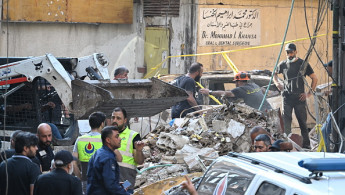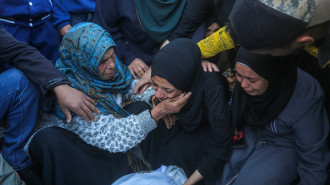What is Israel's 'Arrows of the North' operation in Lebanon?
Israel on Monday launched an intensified and wide-scale attack on Lebanon, with the Israeli military announcing the operation name of "Northern Arrows", or "Arrows of the North".
The strikes were centred on southern Lebanon, on what Israel claimed was "1,600 Hezbollah positions", with the Israeli military claiming it was focusing its fire on the group's cruise missiles, drone capabilities and long and short-range rocket facilities.
However, the realities on the ground tell a different story.
Though Israel warned thousands of Lebanese residents in the south to leave the area, at least 558 people were killed, including 50 children and 94 women, with over 1,835 people wounded.
Most of the killed and wounded are believed to be civilians and the numbers continue to climb as Israel carries out more strikes across southern Lebanon, the Bekaa Valley and the southern suburb of Beirut.
The New Arab looks at the objectives of "Arrows of the North" and why Israel is launching these attacks at this time.
Israeli escalation
Israel and Hezbollah have exchanged near-daily fire since the outbreak of Israel’s war on Gaza last October, with the Lebanese group allied with Hamas. On both sides of the Israel-Lebanon border, thousands of people have been forced from their homes due to the fighting in northern Israel and southern Lebanon respectively.
However, the fighting had mostly been limited to cross-border attacks, with Israel killing 878 people in Lebanon since 8 October 2023, over 400 of which are believed to be Hezbollah fighters.
However, the dead also included at least 150 civilians, with more than 110,000 people displaced from their homes in Lebanon's south.
In northern Israel, Hezbollah refrained entirely from targeting civilians, killing around 23 Israeli soldiers, and leading to some 96,000 civilians being displaced from border towns and villages.
The situation changed dramatically last week when Israel announced it was changing its official war aims to include returning civilians to the north of the country, meaning confrontation with Hezbollah.
A few days later, Israel escalated the conflict even further by detonating booby-trapped pagers and communication devices primarily belonging to members of Hezbollah. In total, 42 people were killed, including 2 children, with over 3,500 wounded.
On 20 September, Israel carried out an air strike that killed the commander-in-chief of Hezbollah’s special operations unit, killing 45 people in the process.
Despite a restrained response from Hezbollah, Israel then launched the brutal ongoing operation known by them as “Arrows of the North”.
Israel launches 'Arrows of the North'
Israel claims the operation is aimed solely at Hezbollah. However, given the high civilian death toll and the residential areas hit by Israel, many believe Israel is using similar tactics to that which it used in Gaza, namely attacking civilian areas in southern Lebanon to terrorise Hezbollah's civilian base of support.
It could also be that Israel is now using major force against Lebanese civilians to pave the way for a ground offensive, as it did in Gaza, something which Tel Aviv has refused to rule out.
There are several reasons why Israel would want to invade south Lebanon, with one being the idea of establishing a "buffer zone" inside Lebanese territory to stop Hezbollah from returning there. However, this seems unlikely, given it would entail Israel occupying Lebanon, something that would attract fierce resistance from Hezbollah, which is much more powerful than Hamas.
The purpose of any invasion as part of or following on from "Arrows of the North" may be an attempt to hugely degrade Hezbollah's military power in the south, regardless of the civilian cost, and push the group north of the Litani River.
US support?
As reported by The New Arab’s sister news outlet Al-Araby Al-Jadeed on Tuesday, Israel's chief ally and arms supplier the US is expecting greater escalation from Israel in its current attack on Lebanon and has already held conversations with Tel Aviv about doing so.
Moreover, the US has allegedly given its full blessing to such an escalation, with Washington coming to understand that diplomacy is now impossible.
The US also expects Hezbollah to eventually hit back to its full capacity, given the large civilian death toll and the targeting of Hezbollah commanders.
The kind of retaliation the US and Israel predict Hezbollah is missile attacks aimed at Tel Aviv. This would then lead to further escalation by Israel – it would very likely lead to a full-scale war, on the same scale as or much more destructive than the 2006 Israel-Lebanon war.
'All-out war' already begun?
Some analysts believe the war has already begun. Amos Harel, writing in Haaretz on Tuesday, said: "Without any formal declarations, Israel and Hezbollah have in practice moved to a phase of all-out war on Monday."
Harel believes that many actors within Israel are hoping for Hezbollah to attack "deep into Israel" so that Israel can then justify "routing" the group.
If Harel is right, the question, and no one, including the UN and US, can rein Israel in, the question then becomes one of a wider regional war, given Hezbollah is allied to Iran and its various proxy forces in Iraq and Syria, as well as their Houthi allies in Yemen.
Even though Iran has shown hesitation at becoming further involved in hostilities with Israel, the current far-right Israeli government, without any external restraint, could push the country into a conflict in the same way it has escalated all the way to war, or the brink of it, with Hezbollah.




 Follow the Middle East's top stories in English at The New Arab on Google News
Follow the Middle East's top stories in English at The New Arab on Google News
![A group of Palestinians, foreign and Israeli activists gather to participated in an olive picking event on the land in the town of Battir, which is under threat of confiscation by Israel in Bethlehem, occupied West Bank on 8 November 2024. [Getty]](/sites/default/files/styles/image_330x185/public/2182930803.jpeg?h=199d8c1f&itok=__0LgGsa)

![People gathered around the rubble of destroyed houses to search for survivors [Getty]](/sites/default/files/styles/image_330x185/public/2024-11/GettyImages-2184733820.jpg?h=199d8c1f&itok=NiM1LO2f)